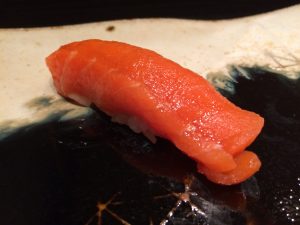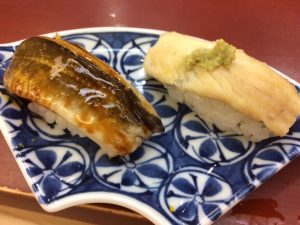 Sushi restaurants that advertise “Edo style” on the sign somewhat fear customers who order Anago (conger eel) right off the bat. If the customer then eats as if they are really taking the time to taste the sushi, then any chef not fully confident in their skills will want to hide under the sushi counter.
Sushi restaurants that advertise “Edo style” on the sign somewhat fear customers who order Anago (conger eel) right off the bat. If the customer then eats as if they are really taking the time to taste the sushi, then any chef not fully confident in their skills will want to hide under the sushi counter.
Anago is a topping that really demonstrate a chef’s skills (or lack thereof).
Edo-style sushi chefs work on many toppings. Anago is a perfect example of these toppings. It is actually first steamed to remove the fat. However, it’s a difficult balance to remove the fat while still leaving the umami. The steamed Anago is then boiled and flavored. Since the fish is plain, the flavoring is also a subtle skill and not an easy task.
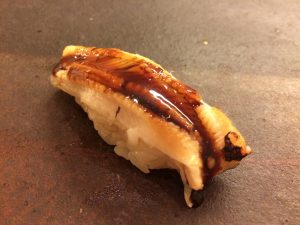
Depending on the shop, the chef may make the sushi with the boiled fish, use Nitsume (boiling down) to bring out the flavor or lightly roast the fish before combining it with the rice. The chef’s ideas and abilities are apparent in the final dish. If the sushi is made from the freshly boiled fish, it should be soft and melt in your mouth…if the chef knows what they are doing! Lightly roasted Anago will have an aroma that fills your entire mouth.
The work this topping takes to serve is a chance for sushi shops to show off their specialties, but it is also a clear indicator of the quality of the shop. The level of the chef and quality of the sushi shop will be revealed as soon as you place Anago in your mouth.
[sc_apply url=”https://sushiuniversity.jp/apply/”]
We hope this information will be helpful.

Revision date: May 27, 2017
Share this article
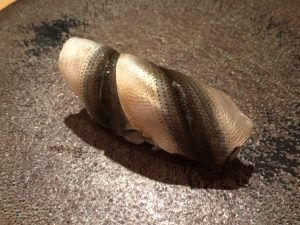 According to most sushi masters, salt is the defining factor in the taste of
According to most sushi masters, salt is the defining factor in the taste of 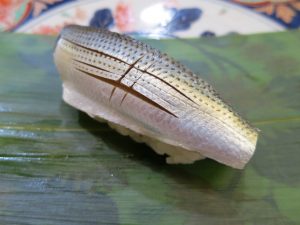 For example, a more slender fish in the middle of summer may be salted for 30 minutes, but a fatty fish in the winter needs to be salted for four hours. Just a few minutes longer or shorter than the perfect salting time completely changes the taste of the final dish.
For example, a more slender fish in the middle of summer may be salted for 30 minutes, but a fatty fish in the winter needs to be salted for four hours. Just a few minutes longer or shorter than the perfect salting time completely changes the taste of the final dish.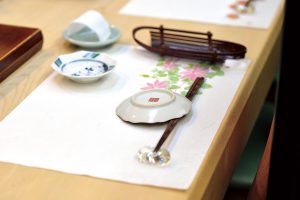 The sushi restaurant is unusual in that the customer sitting at the counter can see the seafood (neta) from which individual servings will be made, and can watch the chef deftly perform his art while enjoying lively conversation. Sushi restaurants also differ from other restaurants when it comes to menus.
The sushi restaurant is unusual in that the customer sitting at the counter can see the seafood (neta) from which individual servings will be made, and can watch the chef deftly perform his art while enjoying lively conversation. Sushi restaurants also differ from other restaurants when it comes to menus.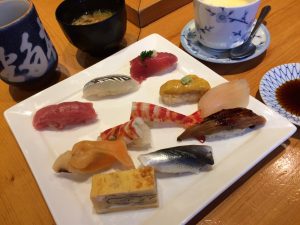 If the customer is inclined to worry about what the bill will come to, he orders
If the customer is inclined to worry about what the bill will come to, he orders 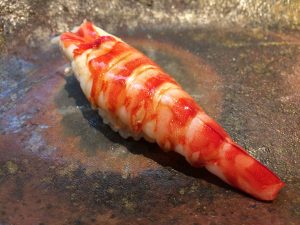 People at the counter most often order
People at the counter most often order 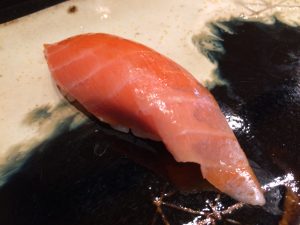 The Japanese were not in the habit of eating salmon raw. Salmon was not a traditional topping in Edo-style sushi. The reason for this is that the existence of parasites has been well-known since long ago and there was no way to prepare the salmon raw.
The Japanese were not in the habit of eating salmon raw. Salmon was not a traditional topping in Edo-style sushi. The reason for this is that the existence of parasites has been well-known since long ago and there was no way to prepare the salmon raw.